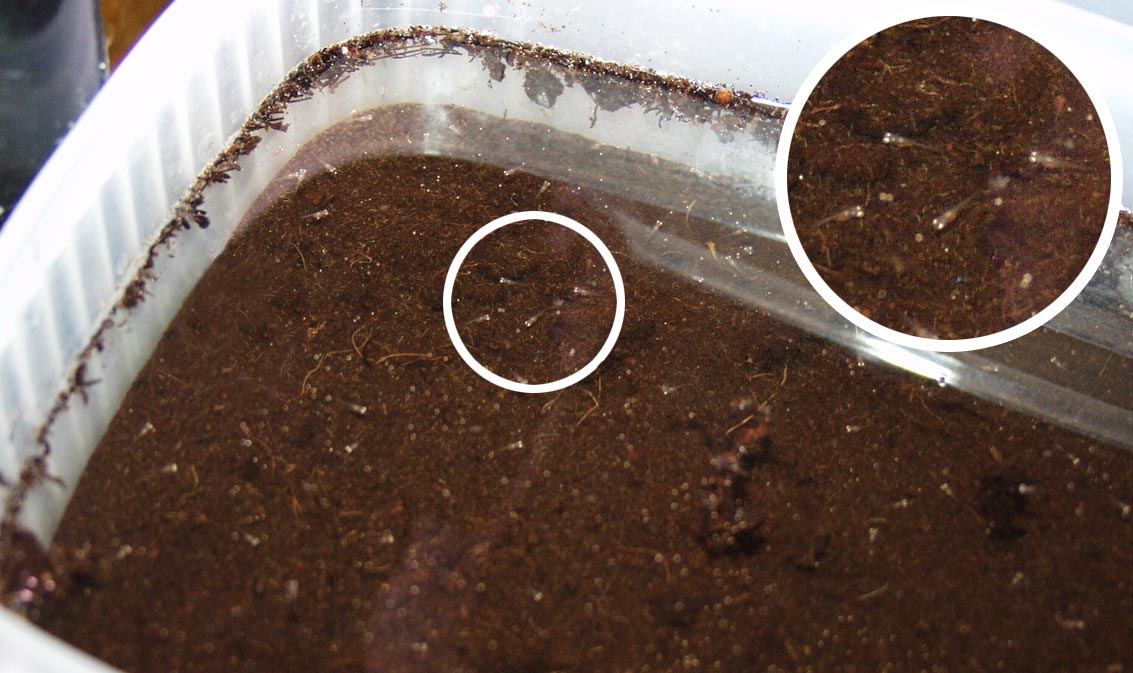The short life-span of annual fish is probably their biggest
disadvantage, if you don't breed them, you soon won't have them! On
the plus side the dry period the eggs go through allows their easy
transportation around the world, and means (to a limited extent)
you can hatch them when you want.
Even though many species of annual fish have predictable
incubation periods, there can be wide variation, and the only way
to be sure that your eggs are ready is to examine them. This is the
egg of a Nothobranchius (in this case melanospilis,
magnification 25x)- the eye can be clearly seen with its golden
iris. This is the best sign that they are ready to hatch. Sometimes
the eggs are not visible; in this case wetting the peat is the only
way to find out whether the eggs are ready. On rare occasions the
eggs can develop in only a few weeks; this often happens with newly
collected species, but there have even been cases of fish that have
been in the hobby for decades still producing a few eggs that
develop very quickly.
When the eggs are ready to hatch place them with the peat into a
container with a couple inches of water. It is important that this
water has a high oxygen content, so keep it cool (16-20°c) and
shallow to start with and add gentle aeration. A high level of
oxygen will ensure that all fry are able to fill their swimbladders
and maintain buoyancy. Fish that fail to do this are known as belly
sliders.
After a day or two the fry can be moved to larger quarters,
either by spooning them out, or sucking them up using a baster or
large pipette. The fry can be raised most easily in a large tank,
shallow at first, which is gradually topped up. Try and include a
few snails, to eat up uneaten food, and a few plants to keep the
water clean and encourage infusoria. This can be accomplished in
several smaller tanks. Even with very frequent water changes it is
very hard to raise more than a handful of these fish in a single
small tank. As the fish grow the largest start to dominate and
should be separated. these are generally males, and will
out-compete some of the smaller (often female) fish. If well fed,
many Nothobranchius will be fully coloured and breeding
several weeks from hatching.

Two day old Nothobranchius fry in a few centimetres of water, above the peat from which they hatched
African annual killifish for sale
London, E1W***, UNITED KINGDOM
$22
Untitled Documenth1{ font-size: 4em;}h2{ font-size: 3 5em;}h3{ font-size: 3em;}body, td, th{ font-family: "Gill Sans " , "Gill Sans MT " , "Myriad Pro " , "DejaVu Sans Condensed " , Helvetica, Arial, sans-serif; font-size: 1 25em;}body{ margin-top: 0%; margin-bottom: 0%; background-color: #FCEBE6; margin-left: 0%; margin-right: 0%;}h6{ font-size: 1 25em;} AquaAholic Nothobranchius Rachovii Beira 98...
more
London, E1W***, UNITED KINGDOM
$22
Untitled Documenth1{ font-size: 4em;}h2{ font-size: 3 5em;}h3{ font-size: 3em;}body, td, th{ font-family: "Gill Sans " , "Gill Sans MT " , "Myriad Pro " , "DejaVu Sans Condensed " , Helvetica, Arial, sans-serif; font-size: 1 25em;}body{ margin-top: 0%; margin-bottom: 0%; background-color: #FCEBE6; margin-left: 0%; margin-right: 0%;}h6{ font-size: 1 25em;} AquaAholic Nothobranchius Eggersi Rufiji ...
more
London, E1W***, UNITED KINGDOM
$22
Untitled Documenth1{ font-size: 4em;}h2{ font-size: 3 5em;}h3{ font-size: 3em;}body, td, th{ font-family: "Gill Sans " , "Gill Sans MT " , "Myriad Pro " , "DejaVu Sans Condensed " , Helvetica, Arial, sans-serif; font-size: 1 25em;}body{ margin-top: 0%; margin-bottom: 0%; background-color: #FCEBE6; margin-left: 0%; margin-right: 0%;}h6{ font-size: 1 25em;} AquaAholic Nothobranchius Foerschi Ruvu ...
more
London, E1W***, UNITED KINGDOM
$22
Untitled Documenth1{ font-size: 4em;}h2{ font-size: 3 5em;}h3{ font-size: 3em;}body, td, th{ font-family: "Gill Sans " , "Gill Sans MT " , "Myriad Pro " , "DejaVu Sans Condensed " , Helvetica, Arial, sans-serif; font-size: 1 25em;}body{ margin-top: 0%; margin-bottom: 0%; background-color: #FCEBE6; margin-left: 0%; margin-right: 0%;}h6{ font-size: 1 25em;} AquaAholic Nothobranchius Guentheri (Red) ...
more
London, E1W***, UNITED KINGDOM
$24
Untitled Documenth1{ font-size: 4em;}h2{ font-size: 3 5em;}h3{ font-size: 3em;}body, td, th{ font-family: "Gill Sans " , "Gill Sans MT " , "Myriad Pro " , "DejaVu Sans Condensed " , Helvetica, Arial, sans-serif; font-size: 1 25em;}body{ margin-top: 0%; margin-bottom: 0%; background-color: #FCEBE6; margin-left: 0%; margin-right: 0%;}h6{ font-size: 1 25em;} AquaAholic Nothobranchius Eggersi Blue...
more

